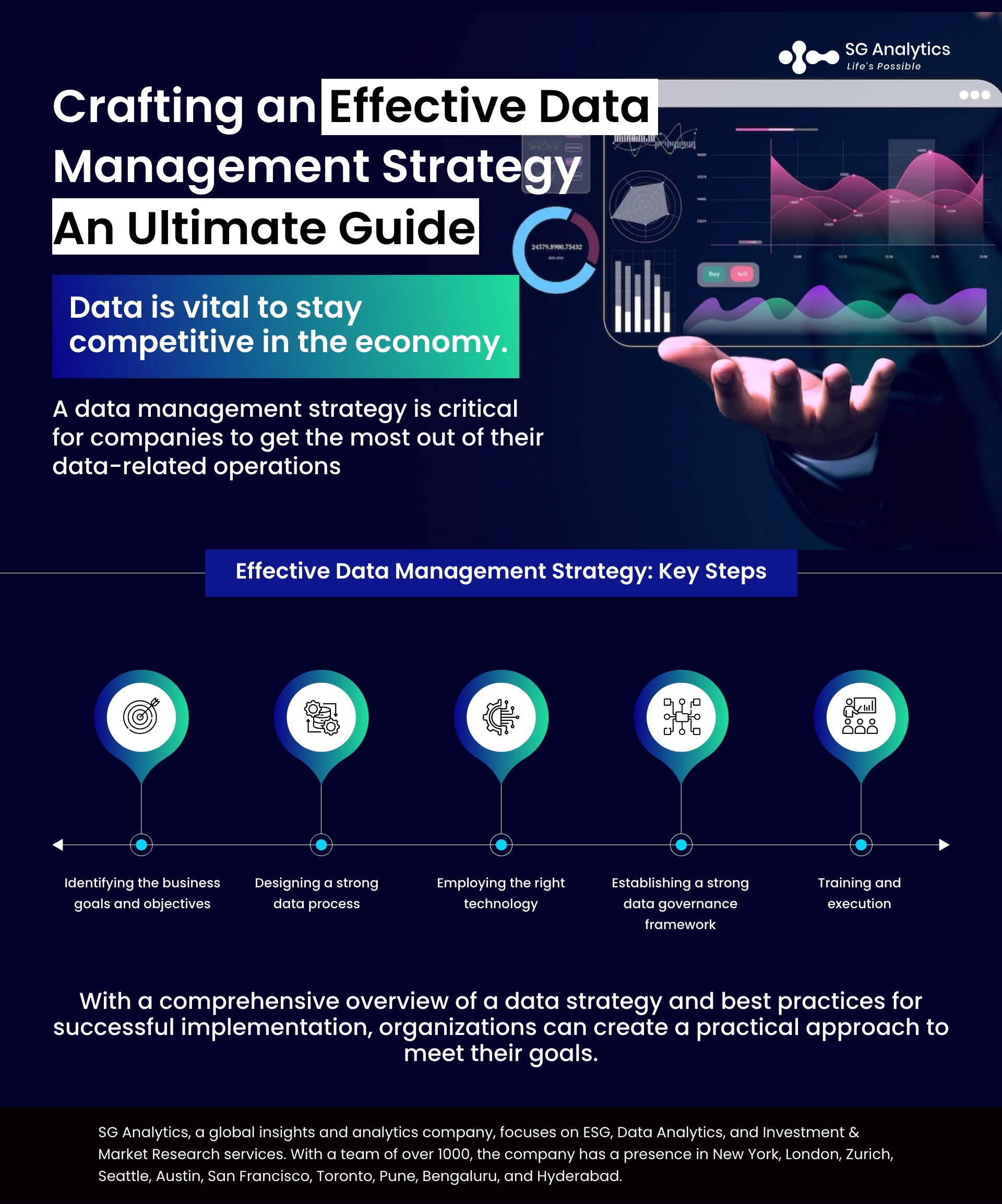Today, data is vital to stay competitive in the economy. However, collecting, analyzing, and managing data is a challenging task. That is why organizations identify and incorporate new strategies or frameworks for managing data. A data management strategy is emerging as the foundation for any data management program. The approach provides the right framework as well as the architecture that will last throughout the life of the data program.
What is a Data Management Strategy?
A data management strategy can be organised, stored, and utilise data within an organization to meet the set objectives and goals. The strategy involves assessing the existing state of the data and developing guidelines and frameworks to ensure it is used effectively. Organizations can increase their efficiency, reduce costs, and gain a competitive advantage with a successful data management strategy.
A data management strategy is a roadmap for an organization to use data to achieve its goals. This roadmap assures that all the actions surrounding data management, ranging from collection to collaboration, work effectively and efficiently and are easy to govern. A data management strategy is a strong foundation required for consistent project approaches and successful integration.
With the right data management strategy in place, an organization can avoid some of the following common data challenges:
Read more: Data Management Framework: Importance, Components, and Examples

- Incompatible or missing data from undocumented or inconsistently documented data sources
- Siloed projects that employ the same data but duplicate the efforts or costs associated with the data
- Data activities that are time- and resource-consuming but do not contribute to the set business objectives
Data management strategies are devised to help enterprises organize their data for quick assessment. The goal is to assemble a framework where all information is stored in one place for employees to access whenever needed. A data management strategy further assists businesses in outlining a high-level course of framework to enable data management.
A data management governance model involves employing structured and unstructured data sources and cloud-based or on-premises solutions based on the organization's requirements. Data management is all about:
-
Authorizing insightful data analytics with accurate, consistent, and reliable data
-
Ensuring data security and privacy with regulatory requirements
-
Managing data infrastructure in a cost-efficient manner
-
Fostering data literacy across the organization
It is critical for organizations to understand that data management is not a one-time initiative but rather a continuous program that is complex. Depending on the industry and business requirements, data management strategies can vary.

Data Management Strategy: Key Steps
Today, the exponential growth of graph technology used in data modeling strategy is fostering efficiency, speed, and flexibility. Automating complex and time-consuming tasks allows businesses to make sense of data to derive critical insights.
To overcome these challenges, it is important for organizations to develop an effective enterprise data management strategy. However, fine-tuning and finalizing a procedure that works best for the business takes time.
Let's explore some key steps in building an effective and lasting strategy for managing data.
Read more: Data Management Tools
-
Identifying the Business Goals and Objectives
Every organization creates billions of data points every day. If the business objectives are not in unison with the data management strategy, organizations could be wasting their valuable time and resources by accumulating, storing, or analyzing the wrong data types. It is, therefore, important to ask the following questions:
-
What are the organization’s overall objectives?
-
What data is required to meet the set objectives?
-
What insights are required to make progress against these initiatives?
By majorly focusing on the most critical use cases for the company’s data and building strategy from there, businesses can define their priorities and determine the processes, tools, and governance.

-
Designing a Strong Data Process
Now that an organization is well aware of how to use the data, it is time to think about the data processes in place for collecting, preparing, storing, and distributing. They can start by identifying the owners as well as the stakeholders for each of the following data management activities.
- Collect
- Prepare
- Store
- Analyze
- Distribute
-
Employing the Right Technology
To establish and build a precise data management framework, it is vital for an organization to identify the right tools or technological solutions. They need to think about the hardware or software required to establish a strong data infrastructure and manage the data within their existing analytics environment. By streamlining the data process, organizations can collect the information they require when and where they need it in the flow of their analysis. From data preparation and cataloging to search and data governance, with the right technological framework, organizations can ensure that they have access to trusted and up-to-date data to drive business decisions.
Read more: What are Data Services and Its Types?

-
Establishing a Strong Data Governance Framework
The increased use of data and the growth in data infrastructure brings along big benefits as well as big responsibilities. It is, hence, significant to establish a strong data governance framework and create and communicate policies and procedures for data usage. Some of the themes to explore when establishing a data governance framework include:
-
Data quality: Ensuring that the collected data is accurate, complete, and current.
-
Data security: Employing steps to store data securely.
-
Data privacy: Have permission to collect and use data.
-
Data transparency: Incorporate measures to foster an ethical data environment.
The data governance framework enables organizations to ensure that the accumulated data is used correctly and consistently across the operational framework. It also helps in identifying that the policies and procedures are understood by owners, stakeholders, and everyone in the organization. This further helps in fostering an organization-wide data culture.
-
Training and Execution
The biggest challenge for organizations in using data effectively is that the data owners are not always data experts. A critical part of a data management strategy is to provide the right knowledge and skills required to analyze and understand the data. This could imply positioning data analytics tools in the hands of departments outside of IT or gaining buy-in from the organization’s leadership to support the data initiatives. Organizations need to ensure that everyone understands the data management strategy and ways to execute their role successfully.
Read more: Building an Effective Data Governance Strategy: An Ultimate Guide

Summary - Data Management Strategy
The importance of data is expected to increase as AI/ML solutions become more and more mainstream. Augmented analysis is empowering organizations to identify business opportunities through larger data sets available for discovery. The data is used to design predictive models that anticipate customer requirements and drive innovation in products and services.
Conclusion - Data Management Strategy
A data management strategy is critical for companies to get the most out of their data-related operations. By understanding the different data management strategies and implementing best practices, organizations can ensure that they are managing their data to maximize its value. Thus, the data management governance model should be evaluated when making decisions.
A data framework is critical, as it offers the structure required for efficient data storage as well as retrieval. The new-age technologies offer a windshield view for businesses, thereby equipping them with a better vision of where the company is going. However, these benefits will be out of reach without a proper data management strategy.
With a well-developed data management model, organizations can witness far-reaching benefits, such as improved accuracy, increased automation productivity, and reduced streamlining process costs. With a comprehensive overview of a data strategy and best practices for successful implementation, organizations can create a practical approach to meet their goals.
With a presence in New York, San Francisco, Austin, Seattle, Toronto, London, Zurich, Pune, Bengaluru, and Hyderabad, SG Analytics, a pioneer in Research and Analytics, offers tailor-made services to enterprises worldwide.
A leading enterprise in Data Analytics, SG Analytics focuses on leveraging data management, analytics, and data science to help businesses across industries discover new insights and craft tailored growth strategies. Contact us today to make critical data-driven decisions, prompting accelerated business expansion and breakthrough performance.









